Is your dog’s head feeling a little too warm lately? Finding out that your dog’s head seems hotter than usual can be worrying. But in many cases, there are some simple explanations for this symptom. But questioning “Why is my dogs head hot?” will be a common start.
Determining why your dog has a hot head is important, as it can point to issues like infection, inflammation, heat stroke, and more. With the right treatment and prevention methods, you can help your pooch feel comfortable again.
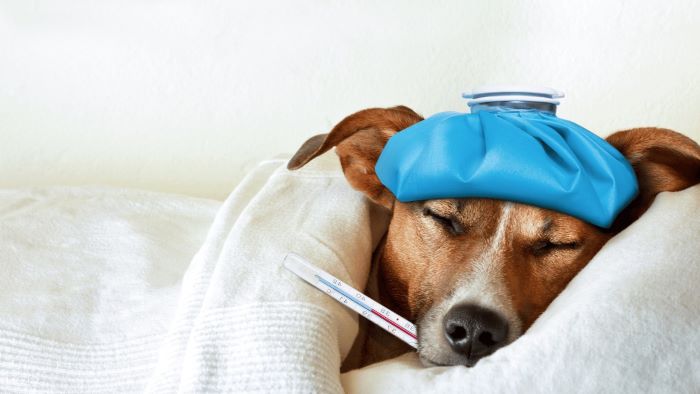
What’s Considered a Normal Temperature for a Dog’s Head?
Before delving into the reasons behind an overheated head, it helps to understand what’s considered a normal temperature range. A healthy dog’s head temperature typically ranges between 100-102.5°F. Factors like excitement, exercise, and hot environments can cause a slight increase within this range.
Usually, you can get a general sense of your dog’s head temperature by feeling their nose. A wet, cool nose indicates normal temperature, while a dry, warm, nose points to a slight elevation. Panting is another sign of warming.
Common Causes of a Hot Head in Dogs
If your dog’s head seems significantly hotter than normal, some key health issues may be to blame. Here are some top reasons for an overheated head in dogs[1]:
Infection – Bacteria and viral infections can cause inflammation and fever, increasing head temperature. Skin infections on the head are a common culprit.
Inflammation and Pain – Injuries, dental issues like abscesses, and arthritis can all contribute to inflammation and discomfort that makes your dog’s head feel warm.
Heat Stroke – Dogs are susceptible to overheating and heat stroke, which can be life-threatening. Heavy panting, drooling, and extremely hot head and body point to this.
Allergies – Allergic reactions to food or environmental allergens can stimulate inflammation that warms your dog’s head.
Anxiety – Stress and anxious behaviours like obsessive licking can increase circulation to the head.
Overexertion – Vigorous exercise in hot weather can cause hyperthermia. The head is one area that overheats.
Systemic Illness – Some illness that affects the whole body, like cancer or autoimmune disease, can also raise body temperature.
Pay attention to other symptoms that provide clues about the cause. For example, lethargy, reduced appetite, vomiting, and diarrhoea can indicate infection or systemic issues. Lameness, crying out, and reluctance to eat can point to injury or dental problems.
Warning Signs Your Dog’s Head Is Hot
Along with feeling your dog’s head, look for these signs of overheating:
- Dry, warm nose
- Heavy panting
- Red eyes
- Increased drooling
- Lethargy and weakness
- Warm ears
If your dog is showing multiple symptoms, it’s especially important to determine the reason and get treatment. Serious heat stroke requires emergency veterinary attention.
When To See The Vet About A Hot Head
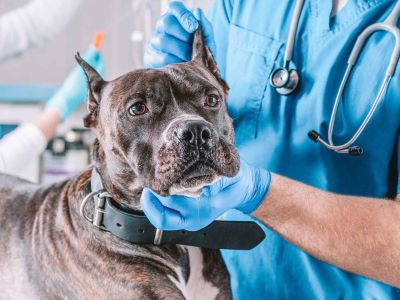
Watching out for symptoms and using cooling techniques may be enough for a mild temperature increase. But in many cases, a veterinary visit is warranted:
- Seek emergency vet care if your dog has symptoms of heat stroke, like extremely high temperature, collapsing, seizures, or coma. This is a medical emergency.
- For a moderate to high fever over 103°F, particularly if it lasts over 24 hours or comes with other symptoms, veterinary attention is recommended.
- If your dog’s head is hot along with lethargy, appetite/behaviour changes, or other symptoms, consult your vet to determine if infection or another issue is present.
- For mild low-grade fever under 103°F, home monitoring may be okay at first. But if it persists over 48 hours or worsens, a veterinary examination is a good idea to pinpoint the cause.
Next Steps: Diagnosing The Cause of A Hot Head
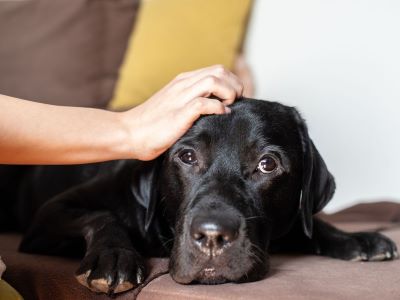
If your dog is showing signs of a significantly elevated head temperature, your vet can use the following approaches to determine what’s responsible:
Medical History – Let your vet know when you first noticed your dog’s head was hot, any pertinent symptoms, and if your dog has had similar episodes before. Recent injuries, changes in diet/environment, and travel will also be helpful details.
Physical Exam – Your vet will thoroughly examine your dog’s head, eyes, ears, mouth, lymph nodes, and overall body to pinpoint areas of concern. They’ll assess temperature and check for injury, infection, and pain.
Diagnostic Tests – If needed, tests like bloodwork, urinalysis, biopsies, and imaging (x-rays, CT scans) can check for underlying problems and illness. Cultures can identify infectious organisms.
Once the underlying cause is found, appropriate treatment can begin to bring your dog’s temperature down and address the source of overheating.
Treating Your Dog’s Hot Head: Cooling Methods and Medical Care

If your dog is dealing with an uncomfortable hot head, getting the temperature back to normal and treating the underlying cause are key. Here are some treatment approaches your vet may recommend:
Cooling Techniques to Bring Temperature Down
- Apply cool, wet towels to the head, neck, and paws to draw out heat. Switch towels often as they warm. Avoid very cold water that can constrict blood vessels.
- Use a fan to circulate cool air around your dog. Direct airflow away from your dog’s face and ears initially.
- Offer cool drinking water frequently, but avoid cold water that could cause vomiting.
- Wet your dog’s ears and paws with cool water. Blood vessels in these areas help release heat.
- Never submerge your dog in cold water, which can cause life-threatening shivering.
- Once the temperature is reduced, ongoing monitoring at home may be recommended.
Medical Treatment for the Cause
- Medications like fever reducers, pain relievers, antibiotics, antifungals, and steroids can target infection, inflammation, and high temperature.
- Injuries, dental issues, and arthritis may need specialized surgery, treatment, or physical therapy.
- Severe heat stroke requires hospitalization to manage shock, organ damage, and brain swelling.
- Treating underlying illnesses like cancer may involve medications, chemotherapy, radiation therapy, surgery, or alternative approaches.
Preventing Overheating and Hot Spots in Dogs
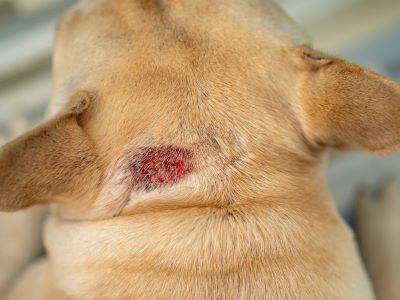
Once your dog’s troubling hot head has been treated, there are some key steps you can take to prevent flare-ups in the future:
Avoid Heat Stroke – Never leave your dog confined in a hot car. Ensure they have shade and water during outdoor play. Limit exercise on hot days. Learn the signs of heat stroke and respond immediately if they appear.
Brush Regularly – Use a soft bristle brush to distribute oils and promote circulation. Regular grooming prevents matting and skin irritation that can cause hot spots.
Check for Allergies – If your dog seems to get hot spots after eating certain foods or being around certain environments, allergy testing can identify triggers to avoid.
Manage Anxiety – If stress seems to overheat your dog’s head due to licking or rubbing, consider behavioural modification, pheromone sprays/collars, or medication to control anxiety issues.
Provide Shade and Water – Ensure your dog always has access to fresh water and shade during periods of sun exposure. Inside, use cooling mats and fans to prevent overheating.
Limit Exercise in Heat – Take shorter, slower walks during hot weather and avoid intense play that could spike body temperature. Walk very early or late in the day when it’s cooler.
With diligence and preventive steps, you can hopefully keep your pooch’s head nice and cool in the future.
Caring For Your Dog’s Head: Bathing, Grooming, Massage
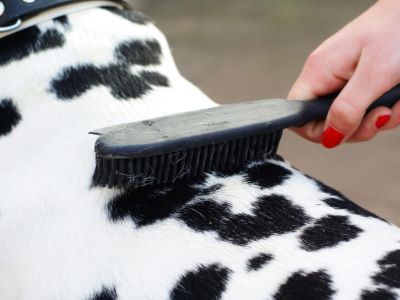
In addition to resolving overheating issues, it’s important to provide your dog with gentle ongoing care and cleaning for their head region:
Bathing – Bathe your dog’s head with a gentle dog shampoo or wipes to control odour, dirt, and skin irritation. Take care not to get soap in its eyes, ears, and nose. Rinse thoroughly.
Grooming – Use a soft brush to keep the hair around your dog’s head free of tangles and debris. Be extra gentle around the eyes, ears, and mouth. Check for sores or hot spots.
Ear Cleaning – Gently wipe inside ears with a cotton ball and dog ear wash to prevent buildup and infection. Don’t insert deep into ear canals.
Teeth Brushing – Regularly brush your dog’s teeth with a pet-safe toothbrush and toothpaste to maintain dental health and prevent painful infections.
Message – Use circular motion to massage your dog’s face, around eyes/ears, and along the jaw to stimulate circulation, relieve tension, and bond with your pup.
With routine care and attention, you can help keep your dog’s head happy and healthy. Alert your vet promptly about any recurrent signs of overheating, discomfort, or infection.
FAQs
Why is my dog’s head hot?
A hot head alone can signify issues like skin infections, dental infections, anxiety, allergies, and injuries focused on the head. But it can also reflect systemic illnesses causing fever.
When should I take my dog to the vet for a hot head?
Seek emergency vet care if your dog has symptoms like collapse, seizures, vomiting, or extremely high fever. For fevers over 103°F or over 24 hours, vet attention is recommended. You should also consult your vet for any recurring head-warming episodes.
Can I give my dog Tylenol for a fever?
No, you should never give your dog any human fever reducers like acetaminophen without consulting your vet first. There are pet-safe anti-inflammatory medications vets may prescribe to bring down fever.
How long will it take my dog’s head to cool down?
With appropriate cooling techniques at home or medical treatment by a vet, your dog’s elevated head temperature should start improving within 1-2 hours. However, it may take 12-24 hours for their temperature to fully normalize again.
What should I do if my dog has a fever and is vomiting?
Fever with vomiting indicates your dog needs to be evaluated by a vet right away, as this can point to a serious infection or illness. Do not give any medications by mouth until the vet can determine the cause.
Conclusion
A hot head can be a distressing sign that something is amiss with your pets. Paying attention to head warmth and other symptoms can help you determine if there is an underlying issue needing treatment. While certain causes like heat stroke demand emergency care, milder cases may call for cooling, rest, and veterinary monitoring.
With prevention methods like brushing, dental care, anxiety reduction techniques, and sensible precautions during heat waves, you can hopefully stop recurrent head-warming in its tracks. Stay alert about head temperature fluctuations when interacting with your dog. With swift response to overheating and appropriate veterinary treatment as needed, you can keep your pup’s head cool and uncomfortable for years to come.
Reference:
- How to Tell if Your Dog Has a Fever and What to Do About It | petMD



